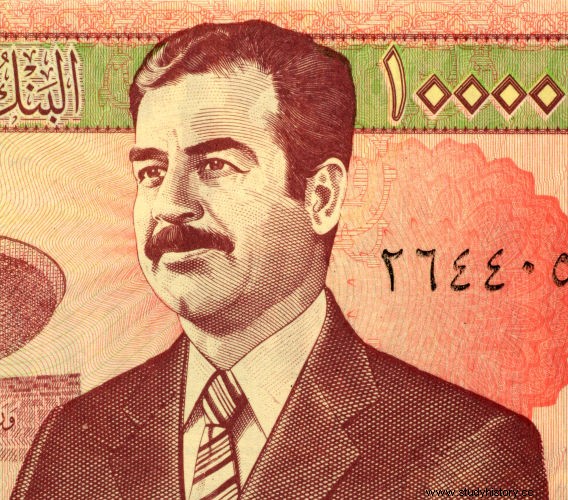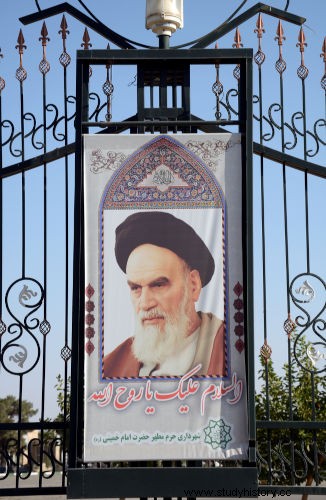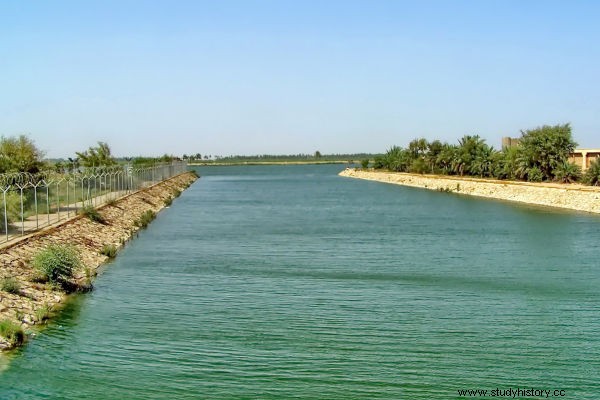
The Iran-Iraq War it was a conflict that lasted from 1980 to 1988, causing an estimated 1.5 million deaths and destroying the economy of the two countries involved. This conflict was largely caused by the Iraqi interest in containing the advance of the Islamic Revolution and the political differences between the Iraqi and Iranian governments.
Access also :Understand the difference between Shias and Sunnis
Iran-Iraq War Summary
-
It was a conflict between Iran and Iraq (1980-1988), causing about 1.5 million deaths.
-
Iraq's main interest in the conflict was to contain the advance of Iran's Islamic Revolution.
-
The two countries had border disagreements over Shatt al-Arab's control.
-
It ended mainly due to the wear and tear that the economy of both countries had after eight years of war.
-
Iraq was supported by countries such as the United States and Saudi Arabia.
Iran-Iraq Relations
The Iran-Iraq War was the result of the context experienced in the Middle East at the end of the 1970s, and the progressive erosion of relations between Iran and Iraq. Both countries were going through quite significant political transformations, and this meant that relations between the two nations were shaken by political and religious issues.
The relationship between the two nations was never good, but events in the 1970s fueled the rivalry. A first point of friction between the two countries concerned the issue religious , since Iran was a mostly Shia nation and had a Shiite government , while Iraq it was a mostly Shia nation, but with a government Sunni and secular.
This issue made the Iranian government a major threat to Iraq, but not only to it, but also to a number of other Sunni-ruled nations in the Middle East. The relationship between Iran and Iraq was further strained by the fact that Iran supported an ethnic minority in Iraq:the Kurds. Iranian support guaranteed the rebellion of this minority.
This political and religious divergence came up against another issue:a dispute from border . In 1975, Iran and Iraq had reached an agreement known as the Agreement from Algiers , in which the disputes between the two nations over the Shatt al-Arab , a canal into which the Tigris and Euphrates rivers flow.
Through this agreement, each country was given one bank of the canal, the east bank of Iran and the west bank of Iraq. The agreement temporarily ended disputes over the border between the two countries in Shatt al-Arab. However, two factors contributed to the relationship fraying again.
Islamic Revolution
In 1979, a great people's revolution took place in Iran , and what was imagined as a popular uprising that could be co-opted by workers' and Marxist movements, became, in fact, a great R evolution I Slamic , which started an extremely conservative government in Iran.
In the 1970s, Iran was ruled by an authoritarian monarchy that was in the hands of Shah Reza Pahlavi . The country was a strong ally of the United States in the region, and, with Saudi Arabia, it tried to guarantee stability in the Middle East, in addition to making a large amount of barrels of oil available to the West.

In 1979, a strong popular opposition movement was established in Iran and, under the leadership of Ayatollah Khomeini, carried out the seizure of power in the country and its transformation into an Islamic nation. A series of changes took place in the country based on very conservative interpretations of the customs of Islam.
Ayatollah Khomeini established himself in power in Iran, Shah Reza Pahlavi fled to the United States, and the important American ally in the region was lost. The new Iranian government has established itself as a government hostile to the United States and as a strong threat to the interests of countries like Iraq and Saudi Arabia.
This is because Sunni-ruled countries have come to fear that the events in Iran will serve to fuel popular uprisings in the Middle East and to stir up Shiite minorities. Shiite empowerment and popular unrest have put a warning sign in the Middle East regarding Iran.
-
Video Lesson on Islamic Revolution in Iran
-
Rise of Saddam Hussein
In 1979, a new government was established in Iraq:that of Saddam Hussein. Born in a village near Tikrit, Hussein was a politician who had joined the Ba'ath Party, which had ruled Iraq since 1968. He saw power through a coup and remained as dictator of the country for over 20 years .
Saddam Hussein's government was Sunni and secular , and he ruled a nation that had the majority of the population being Shia. So there was a strong fear on his part that the Islamic Revolution in Iran could bring unrest in Iraq. He feared that the Shias would rebel, as well as the Kurds.
The relationship between the two nations started to turn bad again when Ayatollah Khomeini started encouraging Iraqi Shiites to rebel against Saddam Hussein. The Iraqi dictator, fearing this rebellion, intensified the repression against the population of his own country, and thousands of Shiites were arrested, and hundreds were killed.
Login also :Ronald Reagan, US President during the Iran-Iraq War Years
Beginning of the Iran-Iraq War
Ayatollah Khomeini's call for Iraq's Shiites to rebel against the government of Saddam Hussein was understood by the Iraqi dictator as direct interference in the country and a violation of Iraqi sovereignty. With that, Hussein announced his intention to withdraw from the Algiers Agreement and resume the dispute with Iran for control of Shatt al-Arab.
To worsen relations between the two nations, Iran has resumed encouraging the Kurds, ethnic minority who lived in southern Iraq. Thus, Saddam Hussein began to demand the revision of the Algiers Accord on the Shatt al-Arab issue, in addition to an end to Iranian interference in Iraq and the granting of autonomy to Sunnis in the territory of Iran.

Saddam Hussein identified that a conflict against Iran could give more legitimacy to its government , ensuring the unity of the country through nationalist fervor against the Iranians. The big point of disagreement was the control of Shatt al-Arab, although historian Osvaldo Coggiola claims that Iraq's main objective in a possible war against Iran was to contain the advance of the Islamic Revolution.|1|
Furthermore, it is important to mention that Iraqi hostility was exploited by nations such as the United States and Iraq, who viewed a possible conflict to weaken Iran with good eyes. Other countries such as Jordan, France and Great Britain have given Iraq economic and military aid.
Relations between nations rapidly deteriorated in the 1980s, to the point where both called for the return of their diplomatic corps. Finally, the war began when Iraq invaded the territory of Iran and began intense bombing, on September 22, 1980 .
Summary of the events of the Iran-Iraq War
When the war started, Iraq's main objective, in addition to containing the advance of the Islamic Revolution, was to conquer the entirety of Shatt al-Arab and Khuzestan, a wealthy Iranian province in oil reserves. Iraq's initial advance was soon contained by the strength of Iranian troops. Iran, in turn, saw in the war a good possibility to expand its territory by conquering Iraqi lands.
The Iran-Iraq War was marked as a violent conflict , one of the most violent after the Second World War, and for not having had great advances on either side. The balance of forces fluctuated a lot during the conflict, and there was an alternation between moments of greater strength in Iraq and Iran.
In addition, the Iran-Iraq War was marred by major trench battles and had very limited troop mobility. Most of the battles took place on Iraqi territory and bombing of civilian targets and oil wells was common. Even the capitals of the two countries, Baghdad (Iraq) and Tehran (Iran), were attacked by missiles.
During the conflict, Iran encouraged the Kurdish population of southern Iraq to rebel against the Iraqi government. This happened and was accompanied by a violent repression on the part of Saddam Hussein. The Iraqi dictator, who had received some chemical weapons from European powers, made use of them in 1988, when he launched a attack chemical against the Kurdish village of Hala b ja, in 1988.
Login also :Gulf War – an offshoot of the Iraq-Iran conflict
End of the Iran-Iraq War
The long duration of the war and the elusiveness of the conflict caused the economies of Iran and Iraq to be completely devastated. In 1988, the UN Security Council introduced a resolution for the two nations to sign a ceasefire . Iraq immediately accepted, but Iran only accepted the ceasefire because of the dire state of its economy.
The war officially ended on August 15, 1988 , when the ceasefire took effect. The 1975 Algiers Accord was re-established, and the division of Shatt al-Arab remained the same as before the war. It is estimated that up to 1.5 million people have died in this conflict between military and civilians.
Note
|1| COGGIOLA, Osvaldo. The Iranian Revolution . São Paulo:Unesp, 2008. p. 103.
Image credits
[1] Georgios Kollidas and Shutterstock
[2] Attila JANDI and Shutterstock
